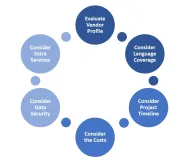Enhanced Ecommerce with Product Data Management in 2024
It’s no news that customers now want more variety. Take Apple, for example: from selling one iPhone in one color, they now offer multiple configurations of the iPhone in different colors.
As companies expand their product/service lines, they generate and store more product data, and improper management of that data can lead to internal and external inefficiencies in the business.
That is where product data management (PDM) comes into play; business leaders, especially in the e-commerce industry, can leverage product data management to obtain maximum value from their ever-increasing product data. That is why the global market for product lifecycle management (of which PDM is a part, as later explained in the article) is rapidly growing.
Figure 1: Product lifecycle management market size from 2021 to 2030
This article is curated to help you yield maximum value from your product data by:
- Exploring what product data management is,
- How it differs from product information management,
- How it can be automated or crowdsourced,
- And how it can benefit your online business.
What is product data management?
To understand what product data management (PDM) is, we should look at product lifecycle management (PLM). PLM is the management of a product’s lifespan, from the production stage to consumption and disposal – sometimes PLM can even go beyond disposal towards recycling or re-using.
Product data management, or PDM, is the process of ensuring that all product-related data is efficiently available to all relevant parties, specifically the design, engineering, and product teams.
Some examples of product data include:
- Product images
- Product titles
- Brand names
- Product designing info and other attributes (style, color, features, shape, etc.)
- Production info (manufacturing instructions, parts info, supplier or vendor details, etc.)
- Pricing details
- Development info (How it was improved from previous versions)
- Description of the product
Product data management (PDM) vs. product information management (PIM)
PIM is part of PDM; the only difference is in the type of data being managed and who manages it.
PDM is mainly done for the design, engineering, and manufacturing teams. PIM, on the other hand, only manages information that can specifically be used for marketing and sales purposes on different distribution channels. For instance, data such as product descriptions on a website comes under PIM. Data regarding the vendors from which the parts were sourced to produce the product fall under the product data category.
However, in real-world applications, these data types can be used collaboratively; for instance, the marketing team can use product specification data to update product descriptions.
What is automated product data management?
Companies now have hundreds, if not thousands, of products. Unilever, for instance, has around 400 brands around the world, each producing a number of products. This means Unilever has an ocean of product data to manage across its brand line-up.
To manage data of this scale, businesses can leverage AI-enabled automated PDM solutions. Such solutions gather data from all relevant sources, store it in a central location on a cloud server, and make it accessible to all relevant departments.
However, the quality of the results of a PDM system is as good as the quality of the data that feeds it. This data needs to be digitalized before entering into the system. For diverse product lines, it is usually not practical for companies to perform data entry manually since it is error-prone and labor-intensive. In such cases, outsourcing/crowdsourcing can be beneficial.
How does product data management benefit your online business?
Some of the key benefits of product data management are:
1. More data integration
The data can be stored and retrieved by all relevant channels in an online business without the risk of duplication since it cross-checks all the data entries with the existing ones. This also facilitates collaborative work between global teams because everyone from everywhere can access the data on the cloud.
2. Smoother supply chain operations
The reduced dispersion and duplication of product-related documents reduces inefficiencies in the supply chain, which ultimately helps to avoid unnecessary prolongation of lead times. For instance, a PDM system can provide product inventory and storage information.
3. Efficient product development.
PDM leads to the smoother and more efficient development of the product since historical data is easily accessible to the engineers/developers to be leveraged in the production process.
4. Higher customer satisfaction and fewer returns
PDM results in higher customer satisfaction and fewer returns.
This is because proper PDM allows for a symmetric exchange of information: The availability, specifications, pricing, and the product’s other factors of interest are relayed to the customer in real time, so they know what they are paying and buying for.
5. Better for SEO
PDM improves the SEO of the product due to accurate and comprehensive product information on the website. For instance, if information such as product images, feature descriptions, dimensions, delivery information, etc. is up to date and accurate, the search engine will rank that product higher.
This results in better visibility and higher chances of attracting a customer’s attention.
Further reading
If you have any questions, feel free to contact us:



Comments
Your email address will not be published. All fields are required.